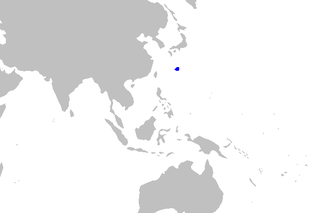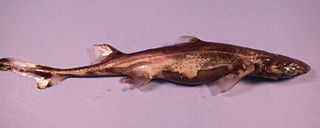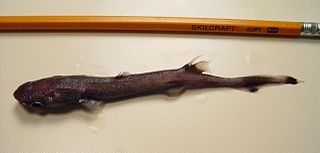There are two species named lined lanternshark:
- Etmopterus bullisi , found the western Atlantic
- Etmopterus dislineatus
There are two species named lined lanternshark:

The Etmopteridae are a family of sharks in the order Squaliformes, commonly known as lantern sharks. Their name comes from the presence of light-producing photophores on their bodies. The members of this family are small, under 90 cm (35 in) long, and are found in deep waters worldwide. The 45 species are placed in five genera. Three-quarters of the species are in the genus Etmopterus.

The rasptooth dogfish is a dogfish, found on the Kyushu–Palau Ridge in the northwest Pacific Ocean at depths of 360 m. Its maximum length is unknown. This species was originally described as Centroscyllium sheikoi, and subsequently allocated to the newly named genus Miroscyllium based on anatomical features not shared with other Centroscyllium. More recent molecular data suggest this species belongs to the genus Etmopterus, but as of June 2014 Miroscyllium sheikoi remains the valid name recognized by FishBase, the Catalog of Fishes World Register of Marine Species, and the IUCN

Etmopterus is a genus of lantern sharks in the squaliform family Etmopteridae. They are found in deep sea ecosystems of the Atlantic, Indian and Pacific Oceans.

The blurred lanternshark is a little-known species of dogfish shark in the family Etmopteridae, found around the world in benthic and pelagic habitats from a depth of 110 m (360 ft) to over 1 km (0.62 mi) down. This shark forms the E. pusillus species group with the smooth lanternshark, which are distinguished from other members of its family by having irregularly arranged, flat-topped dermal denticles that give them a "smooth" appearance. Both species are slender-bodied with long heads, two dorsal fins bearing spines, no anal fins, and light-emitting photophores. The blurred lanternshark is larger, reaching 67 cm (26 in) or more in length. This species feeds on small squid, fishes, and fish eggs, and is ovoviviparous. It has been assessed as of Least Concern by the International Union for Conservation of Nature, because of its wide distribution and lack of threat from fishing pressure.

The smooth lanternshark or slender lanternshark is a species of dogfish shark in the family Etmopteridae, found widely in the Atlantic and Pacific Oceans. It inhabits benthic environments at a depth of 274–1,000 m (899–3,281 ft), and pelagic environments at a depth of 0–708 m (0–2,323 ft). The smooth lanternshark forms a species group with the larger blurred lanternshark, both of which are distinguished from other members of their family by small, irregularly arranged dermal denticles with a truncated shape. This species has a slender, dark brown body with an indistinct black band on the sides over the pelvic fins, and reaches 50 cm (20 in) in length. This slow-growing, ovoviviparous shark feeds on smaller squid, fishes, and fish eggs. Smooth lanternsharks are often caught as bycatch in eastern Atlantic and Japanese commercial fisheries. The International Union for Conservation of Nature (IUCN) has evaluated this species as of Least Concern because of its wide distribution and limited threats.

The velvet belly lanternshark is a species of dogfish shark in the family Etmopteridae. One of the most common deepwater sharks in the northeastern Atlantic Ocean, the velvet belly is found from Iceland and Norway to Gabon and South Africa at a depth of 20–2,490 m (66–8,169 ft). A small shark generally no more than 45 cm (18 in) long, the velvet belly is so named because its black underside is abruptly distinct from the brown coloration on the rest of its body. The body of this species is fairly stout, with a moderately long snout and tail, and very small gill slits. Like other lanternsharks, the velvet belly is bioluminescent, with light-emitting photophores forming a species-specific pattern over its flanks and abdomen. The ventral photophores are thought to function in counter-illumination, which camouflages the shark against predators and prey. The bioluminescent flank markings may play a role in intraspecific communication.

The cylindrical lanternshark or Carter Gilbert's lanternshark is a shark of the family Etmopteridae found along the Caribbean coast of Colombia in South America, at depths of between 285 and 355 m. Its maximum length is 21 cm.

The broadbanded lanternshark is a shark of the family Etmopteridae found in the western and southeast Atlantic, between latitudes 40°N and 45°S, at depths of between 70 and 1,000 m. Its length is up to 35 cm. Reproduction is presumed to be ovoviviparous.

The dense-scale lanternshark is a shark of the family Etmopteridae found in the southeast Pacific off Peru and Chile.

The fringefin lanternshark is a shark of the family Etmopteridae found in the western central Atlantic from Texas to Florida, northern Gulf of Mexico, and Mexico. It is endemic to this area. It is a deep water shark and is found about 220 to 915 meters below the surface, on the upper continental slopes of the Gulf. E. schultzi is a small shark, about 27–30 cm long and feeds on squid. It is also bioluminescent, which counter-illuminates it and helps with intraspecific interaction. Due to its limited range and the difficulty of collecting deep water species, it has not been evaluated by the IUCN Red List, but due to recent oil spills in the Gulf of Mexico, it is likely that fringefin lanternsharks have decreased in population.

The Caribbean lanternshark is a shark of the family Etmopteridae found in the eastern and western Atlantic at depths between 180 and 720 m. Its length is up to 50 cm.

The African lanternshark is a shark of the family Etmopteridae found in the eastern Atlantic between latitudes 12°N and 18°S, at depths between 300 and 1,000 m. Its length is up to 30 cm.

The great lanternshark is a shark of the family Etmopteridae found in the northeast and northwest Atlantic. Its name was given as at the time of its discovery, it was thought to be bioluminescent, but this has been challenged.

The brown lanternshark or bristled lanternshark is a little-known species of deep-sea dogfish shark in the family Etmopteridae. It is found off Japan and New Zealand, and possibly also South Africa and Australia, typically deeper than 300 m (980 ft). This species can be distinguished from other lanternsharks by its coloration, which is a uniform dark gray or brown without the ventral surface being much darker and clearly delineated from the rest of the body. The brown lanternshark feeds on small bony fishes, cephalopods, and crustaceans. Reproduction is ovoviviparous, with females giving birth to 9–18 young. An unusually high proportion of individuals in Suruga Bay are hermaphrodites, with both male and female characteristics.

The blackmouth lanternshark is a species of dogfish shark within the family Etmopteridae. This species is part of a subgroup that includes one other species from within the family. It is known to inhabit the benthic zones of the Eastern Indian Ocean and the Arafura Sea. These sharks were first described in a 2002 issue of Cybium: International Journal of Ichthyology, and there is still much unknown about the species.

The false lanternshark or false pygmy shark is a shark of the family Etmopteridae found in the western Pacific from the Norfolk Ridge and Lord Howe Ridge off New Caledonia.

The West Indian lanternshark is a shark of the family Etmopteridae found in the western central Atlantic, at depths between 400 and 800 m. Its length is up to 31 cm (12 in).

Etmopterus burgessi, sometimes known as the broad-snout lanternshark, is a lanternshark of the family Etmopteridae in the order Squaliformes. It is found only around Taiwan.
E. africana may refer to:

The ninja lanternshark is a lanternshark of the family Etmopteridae found in the eastern Pacific Ocean from Nicaragua, south to Panama and Costa Rica. The depth range of collections is from 836 to 1443 m along the continental slope. E. benchleyi is the only Etmopterus species presently known from the Pacific Coast of Central America.